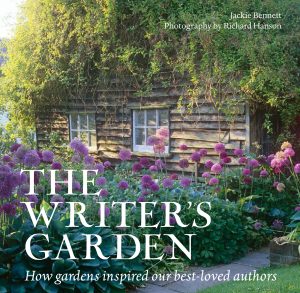The Writer’s Garden
Posted in From the Library on September 26 2016, by Esther Jackson
Esther Jackson is the Public Services Librarian at NYBG’s LuEsther T. Mertz Library where she manages Reference and Circulation services and oversees the Plant Information Office. She spends much of her time assisting researchers, providing instruction related to library resources, and collaborating with NYBG staff on various projects related to Garden initiatives and events.
 The Writer’s Garden: How gardens inspired our best-loved authors drew my eye even before I realized that this new book is from Jackie Bennett, the author of 2016’s Shakespeare’s Gardens (which I reviewed here). Once I realized the authors were one and the same, I knew I was in for a treat.
The Writer’s Garden: How gardens inspired our best-loved authors drew my eye even before I realized that this new book is from Jackie Bennett, the author of 2016’s Shakespeare’s Gardens (which I reviewed here). Once I realized the authors were one and the same, I knew I was in for a treat.
With photographs by Richard Hanson, Writer’s Garden is a very thoughtful and lovely book. Bennett explores the gardens and estates of 19 authors in the United Kingdom. The authors themselves—English, Irish, Scottish, or American by birth—left their marks in the form of their gardens on the British landscape. Bennett is an engaging tour-guide through the landscapes that shaped their works, inspired their art, and became their homes. Using an individual’s garden as a way of telling his or her story is indeed a popular device. At The New York Botanical Garden, there have been several garden-wide exhibitions around this theme. Most recently, FRIDA KAHLO: Art, Garden, Life in 2015, which followed Monet’s Garden of 2012, Emily Dickinson’s Garden: The Poetry of Flowers of 2010, and Darwin’s Garden: An Evolutionary Adventure of 2009.
The essays in Writer’s Garden are all well-researched and engaging. Bennett writes confidently and quite well, and each individual section takes the reader on a detailed journey through significant events and homes of the author being profiled. For the most part, there is a primary landscape or garden associated with each author which is then addressed in detail. Contemporary photos and historic images are woven together artfully. As was the case in Shakespeare’s Gardens, I do wish that the historic images had credit lines accompanying them in the main text, drawing more immediate attention to the special collections that Bennett worked with while writing this book.
One of my favorite chapters was the one detailing the estate of Winston Churchill. While Churchill is a well-known figure to many, I had never known him to be a garden-lover. His indefatigable shaping of his landscape reminded me quite of my own father (also English) and his ambitious home renovations. Something I had not considered about Churchill was his inconsistent income, which naturally led to problems with money. His beloved Chartwell (the estate featured in Writer’s Garden) was put up for sale after WWII. In 1947 it was purchased by a group of his friends, and he and his wife Clementine remained in the house the rest of their lives, after which point the house passed to the National Trust.
A full list of the authors profiled can be found in the catalog record for the book at the NYBG Mertz Library. My other favorites included the gardens of Roald Dahl, Agatha Christie, Ted Hughes, and Beatrix Potter, although all of the chapters were engaging. For readers and gardeners alike, The Writer’s Garden offers intimate and personal glimpses into the lives and landscapes of some of the best-known writers in the English language.

